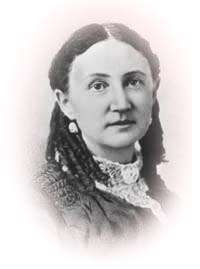Mary Bernard Aguirre
| Mary Aguirre | |
|---|---|
 | |
| Born |
Mary Bernard June 23, 1844 St. Louis, Missouri, United States |
| Died |
May 24, 1906 (aged 61) San Jose, California |
| Nationality | American |
| Occupation | Educator |
Mary Bernard Aguirre (June 23, 1844 – May 24, 1906) was a public schoolteacher and instructor at the University of Arizona. Born in St. Louis, Missouri, she spent her career as an educator in Arizona.
Early life
Bernard Aguirre was the daughter of Joab Bernard, a wealthy merchant. For the first twelve years of her life the family resided in Baltimore, Maryland, the birthplace of Mary's mother. In 1856 the Bernard family moved to Westport, Missouri, where Mary's father owned a large store.
Bernard Aguirre went to college at the age of seventeen; this would prove to be a critical period of her life, as she lived through many moments that eventually changed her views towards people of other races. She heard the rifle shot that killed abolitionist John Brown in Harpers Ferry, West Virginia.
When Mary Bernard returned home from Baltimore, Maryland later that same year, the American Civil War broke out, and she became a supporter of the Southern cause.
Personal life
Mary Bernard married a Mexican freighting contractor, Epifanio Aguirre, on August 21, 1862 in Westport.[1] The Aguirres had three sons: Pedro, Epifanio Jr. and Stephen.
Bernard Aguirre's family moved to the Southwest in 1863. They traveled from Missouri to Las Cruces, New Mexico, with a stop in Santa Fe. Mary kept a journal of her family's travels across the Great Plains.[1]
In Santa Fe, the Aguirres met John Noble, who would later on take them to Arizona.
In August 1869, the Aguirres set foot in Tucson. Soon after, Epifanio Sr. was killed during an Apache raid of a stagecoach. In economic straits, Bernard Aguirre saw herself forced to return home to Missouri and live with her parents.
Career
In 1874, Mary Bernard Aguirre returned to Tucson,[1] having accepted a job as a teacher in Tres Alamos. She taught in Tucson-area public schools, including the Tucson Public School for Girls, for four years. During this time, Bernard Aguirre advocated for public education against the prevailing inclination among Catholics towards homeschooling.
In 1878, she became the first teacher in Arivaca, sixty miles south of Tucson; during her tenure she was recruited to teach at the fledgling University of Arizona.[2]
She became chair of the Spanish language and English history departments at the University of Arizona in 1885.[3] She was the university's first female professor,[2] and resigned from the post in 1901.[4]
Death and legacy
In 1906, Mary Bernard Aguirre was injured in a Pullman train crash in California. On May 24, 1906, two weeks after the accident, she died of internal injuries.
To honor her work during the early years of the school, the University of Arizona currently awards a Women's and Gender Studies professorship in Aguirre's name.[5]
References
- 1 2 3 "Arizona Historical Society, MS 0007: Aguirre Family, 1929-1934" (PDF). Arizona Historical Society. Arizona Historical Society Library and Archives. 1983. Retrieved November 21, 2015.
- 1 2 "Western Women: Neither Civil War nor attacking Apaches stopped her". Arizona Daily Star. Retrieved 2015-11-21.
- ↑ Portrait and biographical record of Arizona. Chapman Publishing Co. ISBN 9785880705672.
- ↑ Regents, University of Arizona Board of (1903-01-01). Annual Report ... University of Arizona.
- ↑ "Mary Bernard Aguirre Professorship". Mary Bernard Aguirre Professorship. University of Arizona. Retrieved November 21, 2015.
- Leo Banks, Stalwart Women: Frontier Stories of Indomitable Spirit ( ISBN 0-916179-77-X)
Women's Plaza of Honor:[1]